Kuhn Air Hammers
[Home] [Back
to Air Hammers]
Pneumatic forging hammers for blacksmiths. Made in Germany.
The information presented on this page for Kuhn air hammers
comes from tool catalogs, blacksmith magazines, and reference materials and
letters from the manufacturer and Centaur Forge.
New style Kuhn air hammers (K/CF22, K/CF40, K/CF50, etc.)
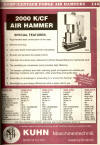
These are the new style hammers currently being produced by Kuhn.
The north American distributor for the newer style Kuhn air hammers is
Centaur Forge. The page scan at left is from the 2003 Centaur catalog. These
new model hammers use very little oil, misting of oil around the hammer is
almost completely eliminated. This was a very new design that was made
possible by advancement in air pump technology that was not available in the
1960s and 1970s when the earlier models were designed. I have no other
information on this new style hammer and have not had the opportunity to see
one of these hammers operating.
Centaur Forge is the north American distributor for the new Kuhn K/CF style
hammers.
European vendor for these hammers is Angele Schmiedetechni, Bahnhofstrasse
23, Reinstetten, D-88416 Ochsenhausen, Tel ++49-(0)7352-92 26-0 Deutschland (Germany)
http://www.angele.de/
Currently not available in the USA.
Manufactured in Augsburg Germany. The manufacturer's website:
http://www.kuhn-maschinentechnik.de/luftschmiedehaemmer_de.html.
Older style Kuhn air hammers ( KB1, K23, K12/42, K24/53 etc.)
These older style hammers are not currently being made. Thousands of
these older style hammers have been in service since the early 1960s.
I have seen the newer model K24/53 hammer working. It was a very simple
design in that there was only the on/off switch, and the throttle control
treadle. As the machine is switched on, the ram immediately lifts and begins to
reciprocate up and down at the top end of ram stroke. As the treadle is
depressed, the ram begins oscillating up and down towards the anvil. Lots of
huffing and puffing and the hammer runs with ease. This hammer runs at around 70
db. Almost no oil misting in the air. Actually I saw no oil misting but assumed
there may be some that I didn't see. The hammer hits nice and hard and has
excellent control. The owner was very happy with the machine.
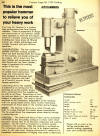
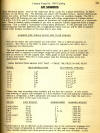
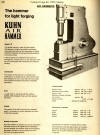
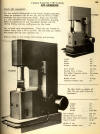
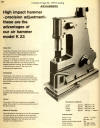
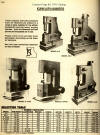 Scans
from old Centaur Forge Catalogs. Centaur Forge printed a lot of
really good information in some of their older catalogs. Here are some scans
from earlier Centaur Forge catalogs. The first 6 pages date back to 1989. And
more recently from the 2003 catalog. Information includes the size of the hammer
and charts showing the comparisons of the sizes of bars that can be forged on a
regular high production or heavier bars that can be forged during "occasional"
work. Great charts for deciding on a size of hammer to purchase. Hammer sizes
and weights, motor horsepower, electrical and other information is given.
Scans
from old Centaur Forge Catalogs. Centaur Forge printed a lot of
really good information in some of their older catalogs. Here are some scans
from earlier Centaur Forge catalogs. The first 6 pages date back to 1989. And
more recently from the 2003 catalog. Information includes the size of the hammer
and charts showing the comparisons of the sizes of bars that can be forged on a
regular high production or heavier bars that can be forged during "occasional"
work. Great charts for deciding on a size of hammer to purchase. Hammer sizes
and weights, motor horsepower, electrical and other information is given.


 Sizes
and weight comparisons. From 1990 Centaur Forge Catalog.
Sizes
and weight comparisons. From 1990 Centaur Forge Catalog.
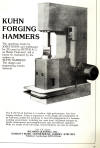 The
name has changed but the hammers were still the same. An advertisement in
the British Blacksmith #47 from March 1988 explains the name change from Reiter
to Kuhn. Kuhn air hammers were sold previously under the name Reiter, and I
think also at one time under the name Berger. Click on the thumbnail at left to
see the full size image from the magazine. Joseph Kuhn was plant manager for
Alois Reiter and he assumed ownership of the company after Mr. Reiter retired.
He continued making improvements and modernizations to this line of hammers and
the modern hammers have many important improvements over the earlier models. The
K/CF hammers are quieter and can run for longer periods of time between
necessary cool down period. For example, the earlier hammers were meant to run
for no longer than 10-12 hours at a time before cooling down for the night. The
later K12/42 - K24/53 models were quieter and could run roughly 12-16 hours
before cooling for the night. The K/CF hammers are also quieter than earlier
models and the latest improvements include a new rotary pump that runs more
efficiently and uses less horsepower to operate and new seal technology that
requires less lubrication and almost entirely eliminates misting of oil around
the hammer.
The
name has changed but the hammers were still the same. An advertisement in
the British Blacksmith #47 from March 1988 explains the name change from Reiter
to Kuhn. Kuhn air hammers were sold previously under the name Reiter, and I
think also at one time under the name Berger. Click on the thumbnail at left to
see the full size image from the magazine. Joseph Kuhn was plant manager for
Alois Reiter and he assumed ownership of the company after Mr. Reiter retired.
He continued making improvements and modernizations to this line of hammers and
the modern hammers have many important improvements over the earlier models. The
K/CF hammers are quieter and can run for longer periods of time between
necessary cool down period. For example, the earlier hammers were meant to run
for no longer than 10-12 hours at a time before cooling down for the night. The
later K12/42 - K24/53 models were quieter and could run roughly 12-16 hours
before cooling for the night. The K/CF hammers are also quieter than earlier
models and the latest improvements include a new rotary pump that runs more
efficiently and uses less horsepower to operate and new seal technology that
requires less lubrication and almost entirely eliminates misting of oil around
the hammer.
Page last updated on
September 17, 2019.

Page created April 16, 2006.










